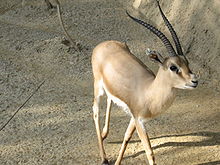
Gazelle
About this schools Wikipedia selection
SOS Children produced this website for schools as well as this video website about Africa. Do you want to know about sponsoring? See www.sponsorachild.org.uk
| Gazelle | |
|---|---|
 |
|
| Rhim gazelle | |
| Scientific classification | |
| Kingdom: | Animalia |
| Phylum: | Chordata |
| Class: | Mammalia |
| Order: | Artiodactyla |
| Family: | Bovidae |
| Subfamily: | Antilopinae |
| Genus: | Gazella Blainville, 1816 |
| Species | |
|
Several, see text |
|
A gazelle is any of many antelope species in the genus Gazella, or formerly considered to belong to it. Six species are included in two genera, Eudorcas and Nanger, which were formerly considered subgenera. The genus Procapra has also been considered a subgenus of Gazella, and its members are also referred to as gazelles, though they are not dealt with in this article.
Gazelles are known as swift animals – some are able to run at bursts as high as 60 mph (97 km/h), or run at a sustained speed of 30 mph (48 km/h). Gazelles are mostly found in the deserts, grasslands, and savannas of Africa, but they are also found in southwest and central Asia, and the Indian subcontinent. They tend to live in herds and will eat less coarse, easily digestible plants and leaves.
Gazelles are rather small antelopes, most standing 2–3.5 ft (61–110 cm) high at the shoulder, and are generally fawn-colored.
The gazelle genera are Gazella, Eudorcas, and Nanger. The taxonomy of these genera is a confused one, and the classification of species and subspecies has been an unsettled issue. Currently, the genus Gazella is widely considered to contain about 13 species. Four further species are extinct – the red gazelle, the Arabian gazelle, the Queen of Sheba's gazelle, and the Saudi gazelle. Most surviving gazelle species are considered threatened to varying degrees. Closely related to the true gazelles are the Tibetan and Mongolian gazelles (species of the genus Procapra), the Blackbuck of Asia, and the African Springbok.
One widely familiar gazelle is the African species Thomson's gazelle (Eudorcas thomsoni), which is around 50 to 70 cm (20 to 28 in) in height at the shoulder and is coloured brown and white with a distinguishing black stripe. The males have long, often curved, horns. Like many other prey species, Tommies and Springboks (as they are familiarly called) exhibit a distinctive behaviour of stotting (running and jumping high before fleeing) when they are threatened by predators, such as Cheetahs.
Etymology and name
Gazelle is derived from the Arabic ġazāl (غزال). The first Latin language to adopt it was Middle French, and the word entered the English language around 1600 from the French. Arab people traditionally hunted the gazelle. Appreciated for its grace, it is a symbol most commonly associated in Arabic literature with female beauty. One of the traditional themes of Arabic love poetry involves comparing the gazelle with the beloved, and linguists theorize ghazal, the word for love poetry in Arabic, is related to the word for gazelle. It is related that the Caliph Abd al-Malik (646-705) freed a gazelle he had captured because of her resemblance to his beloved:
O likeness of Layla, never fear!
For I am your friend, today, O wild deer!
Then I say, after freeing her from her fetters:
You are free for the sake of Layla, for ever!
Species
The gazelle are divided into three genera and numerous species.
- Genus Gazella
- Cuvier's gazelle, G. cuvieri
- Dorcas gazelle, G. dorcas
- Goitered gazelle, G. subgutturosa
- Chinkara or Indian gazelle, G. bennettii
- Mountain gazelle, G. gazella
- Rhim gazelle, G. leptoceros
- Speke's gazelle, G. spekei
- Neumann's gazelle, G. erlangeri
- Genus Eudorcas
- Mongalla gazelle, E. albonotata
- Red-fronted gazelle, E. rufifrons
- Thomson's gazelle, E. thomsoni
- Genus Nanger
- Dama gazelle, N. dama
- Grant's gazelle, N. granti
- Soemmerring's gazelle, N. soemmerringii
Extinct
Fossils of genus Gazella are found in Pliocene and Pleistocene deposits of Eurasia and Africa. The tiny Gazella borbonica is one of the earliest European gazelles, characterized by its small size and short legs. Gazelles disappeared from Europe at the start of Ice Age, but they survived in Africa and Middle East. Three species became extinct in recent times due to human causes.
Recent extinctions
- Genus Gazella
- Arabian gazelle, G. arabica
- Saudi gazelle, G. saudiya
- Genus Eudorcas
- Red gazelle, E. rufina
Prehistoric extinctions
- Genus Gazella
- Subgenus Vetagazella
- Gazella sinensis
- Gazella deperdita
- Gazella pilgrimi- steppe gazelle
- Gazella leile - Leile's gazelle
- Gazella praegaudryi - Japanese gazelle
- Gazella gaudryi
- Gazella paotehensis
- Gazella dorcadoides
- Gazella altidens
- Gazella mongolica - Mongolian gazelle
- Gazella lydekkeri - Ice Age gazelle
- Gazella blacki
- Gazella parasinensis
- Gazella kueitensis
- Gazella paragutturosa
- Subgenus Gazella
- Gazella janenschi
- Subgenus Trachelocele
- Gazella atlantica
- Gazella tingitana
- Subgenus Deprezia
- Gazella psolea
- Genus Nanger
- Nanger vanhoepeni

